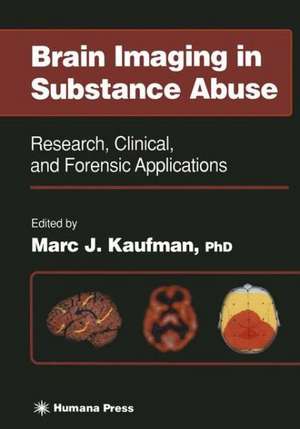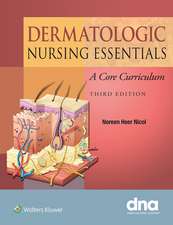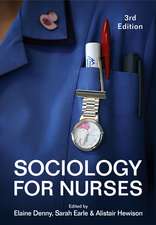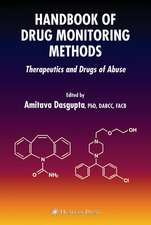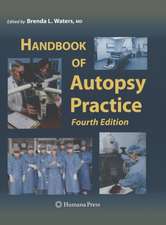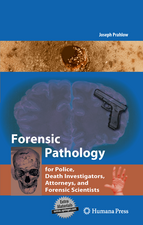Brain Imaging in Substance Abuse: Research, Clinical, and Forensic Applications: Forensic Science and Medicine
Editat de Marc J. Kaufmanen Limba Engleză Paperback – 31 aug 2011
| Toate formatele și edițiile | Preț | Express |
|---|---|---|
| Paperback (1) | 1418.48 lei 38-44 zile | |
| Humana Press Inc. – 31 aug 2011 | 1418.48 lei 38-44 zile | |
| Hardback (1) | 1444.08 lei 6-8 săpt. | |
| Humana Press Inc. – 29 sep 2000 | 1444.08 lei 6-8 săpt. |
Din seria Forensic Science and Medicine
- 5%
 Preț: 773.68 lei
Preț: 773.68 lei - 5%
 Preț: 1348.86 lei
Preț: 1348.86 lei - 5%
 Preț: 1637.37 lei
Preț: 1637.37 lei - 5%
 Preț: 1093.72 lei
Preț: 1093.72 lei - 5%
 Preț: 1285.88 lei
Preț: 1285.88 lei - 15%
 Preț: 696.50 lei
Preț: 696.50 lei - 5%
 Preț: 1418.83 lei
Preț: 1418.83 lei - 5%
 Preț: 1096.62 lei
Preț: 1096.62 lei - 5%
 Preț: 1290.11 lei
Preț: 1290.11 lei - 5%
 Preț: 772.02 lei
Preț: 772.02 lei - 5%
 Preț: 1431.66 lei
Preț: 1431.66 lei - 5%
 Preț: 1953.54 lei
Preț: 1953.54 lei - 5%
 Preț: 1421.06 lei
Preț: 1421.06 lei - 5%
 Preț: 2148.86 lei
Preț: 2148.86 lei - 5%
 Preț: 1430.00 lei
Preț: 1430.00 lei - 5%
 Preț: 1099.20 lei
Preț: 1099.20 lei
Preț: 1418.48 lei
Preț vechi: 1493.13 lei
-5% Nou
Puncte Express: 2128
Preț estimativ în valută:
271.46€ • 282.36$ • 224.11£
271.46€ • 282.36$ • 224.11£
Carte tipărită la comandă
Livrare economică 10-16 aprilie
Preluare comenzi: 021 569.72.76
Specificații
ISBN-13: 9781617371806
ISBN-10: 1617371807
Pagini: 468
Ilustrații: XXV, 425 p.
Dimensiuni: 178 x 254 x 25 mm
Greutate: 0.86 kg
Ediția:Softcover reprint of the original 1st ed. 2001
Editura: Humana Press Inc.
Colecția Humana
Seria Forensic Science and Medicine
Locul publicării:Totowa, NJ, United States
ISBN-10: 1617371807
Pagini: 468
Ilustrații: XXV, 425 p.
Dimensiuni: 178 x 254 x 25 mm
Greutate: 0.86 kg
Ediția:Softcover reprint of the original 1st ed. 2001
Editura: Humana Press Inc.
Colecția Humana
Seria Forensic Science and Medicine
Locul publicării:Totowa, NJ, United States
Public țintă
Professional/practitionerCuprins
1: Electroencephalography, Topographic Mapping, and Event-Related Potentials in Substance Abuse Research.- History of the Electroencephalogram.- Recording the Electroencephalogram.- Analysis of the EEG.- Topographic Mapping.- Artifact Avoidance.- Event-Related Potentials.- Utility of Event-Related Potentials in Substance Abuse Research.- Caveats in Interpreting Electrophysiologic Data in Substance Abuse Research.- Future Directions.- Acknowledgments.- References.- 2: Positron Emission Tomography and Single-Photon Emission Computed Tomography: Methods and Applications in Substance Abuse Research.- Principles Underlying Positron Emission Tomography and Single-Photon Emission Computed Tomography.- Basic Limitations of Positron Emission Tomography and Single-Photon Emission Computed Tomography.- Applications in Substance Abuse Research.- Conclusions.- References.- 3: Fundamentals of Magnetic Resonance.- General Principles.- Magnetic Resonance Spectroscopy.- Magnetic Resonance Imaging.- Functional Magnetic Resonance Imaging.- Other Magnetic Resonance Methods.- Summary.- Acknowledgments.- References.- 4: Electroenc ephalographic Studies of Substance Use and Abuse.- Electroencephalographic Studies of Chronic Substance Abusers.- Discussion.- Acknowledgments.- References.- 5: Emission Tomographic Studies in Substance Abuse.- Alcohol and Alcoholism.- Marijuana.- Hallucinogens.- Benzodiazepines.- Heroin and Opiates.- Cocaine.- Amphetamine and Methamphetamine.- Methylphenidate.- Solvents (“Thinners”) and Toluene.- Conclusions.- Acknowledgment.- References.- 6: Magnetic Resonance Findings in Substance Abuse.- Alcohol and Alcoholism.- Marijuana and Hallucinogens.- Benzodiazepines.- Heroin and Opiates.- Cocaine.- Amphetamine and Other Stimulants.- Solvent Abuse and OccupationalExposure.- Polydrug Abuse.- Concluding Remarks.- Acknowledgments.- References.- 7: Neu ropsychological Correlates of Drug Abuse.- Alcohol.- Marijuana.- Hallucinogens.- Benzodiazepines.- Opiates.- Cocaine.- Amphetamine and Other Stimulants.- Solvents.- Conclusion.- Acknowledgments.- References.- 8: Neuroimages as Legal Evidence.- Science and the Law.- Neuroimages as Psychiatric Evidence.- Substance Abuse, Neuroimaging, and Crime.- Conclusion.- References.- Bibliography of Research Studies in Substance Abuse.- to the Bibliography.- Bibliography Table of Contents.- EEG and Evoked Potentials.- Emission Tomography.- Magnetic Resonance.- Neuropsychology.
Recenzii
Foreword by Joseph Frascella, National Institute on Drug Abuse
"This book is directed to a broad audience, including clinical researchers, physicians, forensic experts, and lawyers. The format and information is most applicable to neuroscience researchers and subspecialists investigating substance abuse. The author is an expert in the field, with an appointment from Harvard medical school....A section is dedicated to the relationship of neuroimaging findings to behavior in substance abuse patients. An intriguing chapter discusses the legal context of using these techniques in court. The exhaustive bibliography on substance abuse research is provided as a reference, useful for future clinical investigation. ...The glossary is appropriate for the audience and essential to comprehending the material....This is a robust text for the investigation of neuroimaging applications in substance abuse research. Explanation of the basic technical details for mainstream neuroimaging modalities are clearly written."- Doody's Health Sciences Book Review Journal
"As the editor states in his preface, this book deals with all aspects of brain imaging in the study of substance abuse and dependence. ... The chapters are followed by a glossary and by an extensive bibliography ( 140 pages!) structured by technique and by substance abuse topic. The index of 25 pages is very detailed and at the same time easy to use. A list of the chosen figures (including 12 colour plates) and tables is included at the beginning of the book. ... This book is aimed at anyone interested in the neurosciences in substance abuse. I especially recommend this book to specialists in forensic medicine. Each library or department should certainly have this book on its shelf." - European Radiology
"This book provides a comprehensive review of the use of brain imaging techniques in the evaluation of brain changes associated with acute and chronic substance abuse." - Acta Radiologica
"As the editor states in his preface this books deals with all aspects of brain imaging in the study of substance abuse and dependence. Thirteen authors, most of them experienced psychiatrists, have contributed to the eight chapters...This book is aimed at anyone interested in the neurosciences in substance abuse. I especially recommend this book to specialists in forensic medicine. Each library or department should certainly have this book on its shelf." - European Radiology
"This book is directed to a broad audience, including clinical researchers, physicians, forensic experts, and lawyers. The format and information is most applicable to neuroscience researchers and subspecialists investigating substance abuse. The author is an expert in the field, with an appointment from Harvard medical school....A section is dedicated to the relationship of neuroimaging findings to behavior in substance abuse patients. An intriguing chapter discusses the legal context of using these techniques in court. The exhaustive bibliography on substance abuse research is provided as a reference, useful for future clinical investigation. ...The glossary is appropriate for the audience and essential to comprehending the material....This is a robust text for the investigation of neuroimaging applications in substance abuse research. Explanation of the basic technical details for mainstream neuroimaging modalities are clearly written."- Doody's Health Sciences Book Review Journal
"As the editor states in his preface, this book deals with all aspects of brain imaging in the study of substance abuse and dependence. ... The chapters are followed by a glossary and by an extensive bibliography ( 140 pages!) structured by technique and by substance abuse topic. The index of 25 pages is very detailed and at the same time easy to use. A list of the chosen figures (including 12 colour plates) and tables is included at the beginning of the book. ... This book is aimed at anyone interested in the neurosciences in substance abuse. I especially recommend this book to specialists in forensic medicine. Each library or department should certainly have this book on its shelf." - European Radiology
"This book provides a comprehensive review of the use of brain imaging techniques in the evaluation of brain changes associated with acute and chronic substance abuse." - Acta Radiologica
"As the editor states in his preface this books deals with all aspects of brain imaging in the study of substance abuse and dependence. Thirteen authors, most of them experienced psychiatrists, have contributed to the eight chapters...This book is aimed at anyone interested in the neurosciences in substance abuse. I especially recommend this book to specialists in forensic medicine. Each library or department should certainly have this book on its shelf." - European Radiology
Textul de pe ultima copertă
With the growing availability and decreasing cost of brain imaging technologies, it has become possible for researchers, physicians, forensics experts, and legal professionals to study brain changes in humans associated with substance abuse. In Brain Imaging in Substance Abuse: Research, Clinical, and Forensic Applications, highly experienced clinical researchers from diverse fields describe the use of electroencephalography, emission tomography, and magnetic resonance imaging to study the neural effects of substance abuse. The authors detail the effects of drugs, including alcohol, benzodiazepines, marijuana, opiates, cocaine, amphetamines, hallucinogens, and solvents on brain electrical activity, metabolism, hemodynamics, receptor and neurotransmitter levels, neurochemistry, and structure. The striking findings they report emerge from more than 1350 articles in some 320 journals, and are organized by method, abused substance and drug use state. The book examines the most commonly used neuropsychological tests and highlights associations between neuroimaging findings and behavior. Comprehensive and readily accessible, Brain Imaging in Substance Abuse: Research, Clinical, and Forensic Applications offers psychiatrists, radiologists, neurologists, pharmacologists, physiologists, psychologists, substance abuse specialists, and legal professionals a broad yet thoroughly integrated understanding of the methods and results obtained with clinical neuroimaging studies of substance abuse today.
